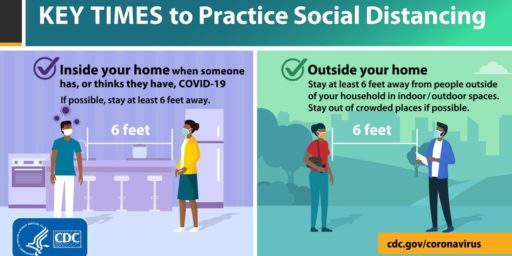People Getting Sick Have Left the House
A completely unsurprising finding.

A weird report from DCist: “An ‘Increasing Number’ Of Infectious People Have Dined At Restaurants, City Officials Say.”
Contact tracing has revealed that an “increasing number” of individuals have dined at D.C. restaurants while infectious with COVID-19 in recent weeks. In addition, tracing has shown that a number of individuals were infectious while recently being in the workplace, according to city officials.
At the Mayor’s press conference Wednesday, D.C. Health Director LaQuandra Nesbitt noted that 10% of positive individuals told contact tracers that they had traveled within two weeks of being diagnosed. These findings come just over a week after the Mayor’s office said anyone traveling to the District from any of 27 states deemed “high-risk,” must self-quarantine for 14 days.
This includes Delaware, which is quite popular with Washingtonians as a summer vacation spot due to its water-side towns like Rehoboth Beach and Bethany Beach.
Many of these findings are in line with what Maryland also revealed last week. A large portion of people who gave Maryland contact tracers information about their activity had attended family gatherings and worked outside the home.
It was always obvious that, unless the virus was eradicated, people leaving lockdowns in their homes and returning to work and recreational activities would be at greater risk for infection. But, like other localities, DC authorities assessed the risk and allowed greater freedom:
In late June, D.C. moved into Phase 2 of reopening, which allowed for limited-capacity indoor dining, slightly larger gatherings, and for non-essential retail businesses to reopen. However, since that time, cases have continued to rise and D.C.’s data shows an increasing trend of cases in the community dating back to the beginning of July.
We’ve gradually opened the college and will welcome a new class of students, delayed by a month, in three weeks. Those students and faculty in the safest category will be in-resident, with appropriate safeguards taken. Others will be remote.
While we strongly considered taking a family vacation this summer—especially since multiple home sales and a move made it impossible last year—we ultimately decided that the risk was too high. But we have dined out in restaurants a handful of times—mostly outdoors but twice inside when it was literally us and the waitstaff.
We weren’t going to be able to sustain lockdowns forever. Indeed, they lasted longer than expected. But it’s a blinding flash of the obvious that people are more likely to get sick as we reopen than they were during the lockdown.






As we move to autumn and activities move in doors in the north, we will see a large spike in infections. Socializing outside is relatively safe and people won’t stop socializing, so they’ll move it in doors till the spike occurs and states begin shutting down bars and restaurants.
On a brighter note, the cooling temps of autumn will likely reduce infection rates in the south, as people can move outside and not need air conditioning.
My greater fear is that American’s unwillingness to take their castor oil will result in the current recession being ‘L’ shaped rather than ‘U.’
@Sleeping Dog:
With the possible exception of masks, which were unfortunately politicized, I’m not sure Americans have been any less willing to endure lockdowns and other hardships than any other Western country. Indeed, I’m pretty sure we endured them longer than Italy, France, the UK, Germany, and others. Our government simply failed us on testing and tracing.
This is not weird at all. It is totally predictable in the mathematical sense that when you have more indoor contact without masks, cases will go up. Similarly, New Mexico recently closed down indoor dining, and cases are going down.
I guess this is weird if you’ve always been in the “Oh, I just don’t understand math” camp and think that’s a cool place to be.
If we had some leadership, the exhortations would be to stay away from other people, and no, we can’t afford to dine indoors yet. That “afford” is in terms both of the economy and our general state of health. The economy isn’t going to come back when some large fraction of the population is sick. And it looks like many who are infected, even the “mild” infections, have lasting health effects.
Sorry if this sounds judgy, James, but you’re contributing to the problem when you say, oh well, people just feel like going to restaurants. Nothing we can do about that.
And no, our “lockdowns” have been a great deal less than what other nations have managed.
The reality is we never actually “locked down”. We took half measures because we didn’t think it was politically possible to actually lock down and, as a result, we are the only highly-developed economy/country to not get it under better control. We are idiots.
@James Joyner: yeah, that isn’t true. Lock downs in most of Europe were far more stringent than ours. they were actual lock downs.
Just saw this when I went back to Twitter.
Another good article here.
From the New York Times article:
“This isn’t actually rocket science,” said Dr. Thomas R. Frieden, who ran the New York City health department and the C.D.C. for a combined 15 years. “We know what to do, and we’re not doing it.”
@Cheryl Rofer:
That’s not what I said, Cheryl. I said, “DC authorities assessed the risk and allowed greater freedom” and then quoted their Phase 2 guidelines. It may well be that they did a poor risk assessment or did so under political pressure from their constituents, including restaurant owners. But people are naturally going to start returning to normal if their leaders tell them that it’s okay. Especially when it seems like they’re taking prudent measures, like requiring staff to wear masks and seating customers further apart.
@Cheryl Rofer:
Indeed.
@James Joyner: James, this is the insouciant tone I was trying to capture:
Yes, we have crappy leadership right now. But those of us who have platforms, even small blog platforms, have an obligation to do better.
Our “lockdowns” were way more lenient than those in Europe. Friends of ours were astonished that we could come and go freely–most of them were at risk of fines and tickets if *they even left the house.* It was nearly 10 weeks before they could let their children play outside.
We’re definitely going to see shifts in where and how the virus spikes. I’m trying to schedule all of my routine health appointments–mammograms and such–before school starts here. I’ve already warned my husband that we’ll be going back to March/April standards soon. We’ve kept our circles fairly small, but have visited with friends in outdoor settings. That will all cease come October.
@Cheryl Rofer: The NYT piece was quite good. Indeed, I commented on it here yesterday.
@SKI: Some of Europe, not all. Spain and Italy essentially. Not that different in other countries on paper, except more coherent and effectively applied.
@Lounsbury: Not all but most, which is what I said, in terms of practice.
The actual restrictions in most were greater than those in almost all of the states. See here for a chart of the European countries, what they did and when they did it.
@Cheryl Rofer:
It’s a version of the standard conservative mantra, “That’s just the way things are, nothing can be done.” which they apply to all situations.
@Cheryl Rofer:
I guess it comes down to whether its a true statement or not. Saying something that actually is true never contributes to the problem — true is true, however unfortunate that truth might be. The problem is that he says there’s nothing we can do about that, and that’s likely incorrect — people’s attitude can be changed. Not easily, not cheaply, but it can be done.
@Jen:
Europe isn’t a uniform entity, different countries had different levels of lockdown. America had more lenient lockdowns than some, and stricter than others.
For that matter, America isn’t a uniform entity either, from what I’ve read different states had different levels of lockdown too. The best way to see if the lockdowns were at the correct level in a given location is to look at the Covid-19 stats for that location. In both Europe and America, some places seem to have responded reasonably well going by their stats, others not so well.
@Northerner: Of course. I shouldn’t have to state the obvious.
By and large, Americans were far more free to come and go, even at the height of the “lock down” here, than Europeans were, again, by and large. Sweden had no lockdown. Italy did. And yes, New York versus Texas versus Illinois were all different. It shouldn’t be necessary to point this out.
As indicated in my post, we have friends sprinkled throughout Europe. Their movements were far more restricted than ours, for a longer initial period.
@James Joyner:
Given that large parts of the country, shut down late, opened early or didn’t shut down at all, I’d say that we wouldn’t take our castor oil. Yes, the northeast and mid atlantic states along with those on the west coast and a smattering of midwestern states. But the south outside LA. and several SW states surely didn’t.
A friend who has homes in Paris and near Nantes, related that in Paris you were required to stay w/in a km of your home and she was fined 500€ for being caught outside that zone.
The math of exponential growth is hard for many to grasp. Essentially it builds up slowly, then seems to suddenly take off.
Take the classic problem: A water lily patch doubles in size every day. If it takes 30 days to cover the full area of a lake, how long does it take to cover half the lake?
The intuitive answer is 15 days. The right answer is 29 days.
But how long does it take to cover 1/4th of the lake? 28 days.
If you were watching the patch grow daily, it seems to do so slowly. Then at day 28 it’s appreciably large, then the next day it’s almost taken over. A day later it’s literally everywhere.
It took the US about 2.5-3 months to reach a million cases. Then under two months to add another million, then one month to add a third million, then 15 days to add a fourth.
Yes, it’s that bad.
@Jen:
But how useful is it then to generalize America and Europe given the wide range of lockdowns within each?
I have friends in various parts of Europe too — some had basically no lockdown (I have a few Swedish friends), some very tight lockdowns (Italy). Averaging their level of lockdown wouldn’t describe what either experienced.
It strikes me as more useful to go through each location (country, state, province etc, whatever the level that had responsibility for the location’s response) and see what their results were. Some locations did well going by the stats. Others didn’t, and should change their responses accordingly.
There’s also the psychological effect of what the country’s leader said and did, even if they didn’t have a lot of direct control. Trump definitely did far worse than any other leader I’ve heard of in that regard. But that’s a different issue than the extent of the lockdowns, which from what I’ve read (I’m Canadian) weren’t his to control (a good thing, since he’d probably have had zero lockdowns anywhere).
People on the streets
Ba da beeda be da.
In the course of my daily life I have set up a killer song list. I push play and it goes.
I have been hitting repeat on Under Pressure lately daily.
It fits the times.
Btw, Haim has new shit out.
@Northerner: I guess I’ll just point to the Politico chart that SKI posted a link to and ask, are you aware of any state where non-essential *movement* was banned? Where a state would arrest and/or ticket someone who was outside of their home? That was applied in multiple European countries with a total (rough) population of 394 million people. More people, located in countries within what is commonly known as Europe, had non-essential movement banned outright, compared to the US population of 330 million.
So, is it acceptable to say that in straight numbers, more people were subjected to much more stringent rules restricting their movement than the total number who had such movement restricted in the US. Is that better?
@gVOR08:
Except it’s not what I said. My point is a simple one: DC, like many/most other jurisdictions, allowed restaurants to open with some additional safety measures like distancing. Of course people were going to start going back out to restaurants when that happened. Their government was literally telling them that it was okay. And, yes, that means more people are going to get sick.
Anecdote time:
Yesterday, here in Park City, UT, I decided to run out to grab take out for lunch. There is a chicken Teriyaki Place that I’ve grabbed takeout from several times (Teriyaki Grill – It’s really good!). But I’ve always gone after work (8pm wish), and it’s been empty. So I roll up there yesterday around 12:30, and from outside it looks busy. I open the door, and see EVERY F**KING booth has people in it, 4-6 people per booth, and a line of 20 people, a foot from each other. Think pre-pandemic. 1/2 of the people in line didn’t have masks on. I turned around, walked back to my car, and just sat there stunned. My immediate thought was, “WHAT THE F**K???” It shook me. Utah was a hotspot and numbers are starting to come down, but relative to population, it still has a fair amount of cases.
We are never going to get rid of this thing because… freedom!
@Jen:
I still don’t see how useful the total numbers/averages are, given the large number of jurisdictions (ie places with control over their lockdowns) in Europe and America, and the wide range of lockdowns applied. Neither Europe nor America acted anything like a single entity in this, so what’s the advantage in treating them as such? It doesn’t give any useful information on how any given jurisdiction should act in the future, because the spread in the data making up either Europe or America is so wide.
A more useful averaging would group jurisdictions not by whether they were in Europe or America, but according to their level of lockdown, and then contrast the resulting Covid-19 statistics. Even that runs into complexities related to culture and neighboring countries, but at least it gives direct information of what a given level of lockdown might achieve.
@Kathy: The example of exponential growth that most people see is compound interest. If you put in $100 at 5%, in a year you get $5 interest. But the second year you get $5.25 interest, 5% of $105. Eventually your $100 will double to $200. There’s a rule of thumb that doubling time is 70/r where r is the interest rate, so 70/5 = 14, you’re money will double in roughly 14 years.
COVID is the same, except the interest rate depends on masking etc. and may be negative or quite high. For FL a month or so ago I saw an estimate of R = 1.4, which is equivalent to 40% interest. And it isn’t per year. It’s per the time an infected person is infectious, which seems to be about ten days. So it’s 40% interest every ten days. 70/40 = 1.75 periods = 17.5 days for cases to double. Then another 17.5 to double again. And so on unless something changes.
Fortunately new cases in FL seem to be leveling, probably due to greatly increased masking driven by scary headlines and Walmart. And it’s possible Guv DeUseless is fudging the numbers. But I already see mask use dropping of and we’re restarting schools, so who knows what R may be next month.
@EddieInCA:
Until we get an effective vaccine. And then we’ll only slow it down because half of us won’t take the vaccine — because freedom! (And some of us may not take it for fear of what corners may have been cut.)
@gVOR08:
I wouldn’t hesitate to take the vaccine–except, as you say, for the fear of cut corners. That does worry me some. But I’ll very likely override those fears.
@gVOR08:
All day at work yesterday the only customer who objected to wearing a mask was visibly dirty, wearing a trump hat, and he stunk. He was also a complete idiot, but you probably could’ve guessed that. We told him it was either wear a mask or hit the door.
@Teve:
These people are totally convinced that Covid-19 is a scam and that Dr. Fauci (they call him Dr. Fraud-ci) is a Deep Stater planted by George Soros to take down Donald Trump.
@James Joyner :
Did I miss armed and angry nuts breaking into legislative sessions to “protest” not getting haircuts around the world? Where else did people deliberately clog up traffic and block a hospital because they were impeded slightly in spreading their disease? People whining a business wasn’t considered essential because they refuse to understand the world doesn’t mean “special privilege” or “something I want so allow it”? Businesses opening up in blatant defiance of law, then going on TV bragging about it and showing off their huge, illegal crowds? There were unhappy people the world over but only in America does it seems that “lockdown” was synonymous with “death camp roundup” instead of “can’t get nails done”.
The ONLY reason we’ve had to deal with hardships longer is because we refuse to do it right and thus prolong the pain. We allowed whiny crazy people to scream “MUH RIGHTS!” and neuter an kind of effective early strategy that would have made this short-term misery instead of months plus damage. I’ve used the analogy before of someone who refuses to get a cavity dealt with, bitch when it gets bad enough for a root canal and keep on not dealing with it till the tooth needs to be yanked and an abscess is threatening to hit their blood stream. We’re currently at apicoectomy levels -looking at having our jaw cut open and tons of stitches ruining being able to eat when a simple filling could have sufficed.
@Northerner: I come from a PR and politics background, so much of my attention is based on messaging–namely, what does it take to get through to people. So definitions matter to me.
In that vein, it’s useful only so far as to differentiate what is meant by a “lock down.” Americans have been whining about how awful this has all been, without recognizing that we’ve really not done anything nearly so strict as other countries.
For most Americans, “lock down” has meant the suggestion of moderate curtailment of their activities. For many others in different countries, it’s meant pretty strict confinement under penalties of significant fines. A number of European countries also closed their land borders–as did the US–but no such restrictions were placed on crossing state lines (indeed, we cannot–states can put some restrictions in place but it’d likely be unconstitutional to outright ban interstate travel).
From a 30,000-foot view of national response, these differences matter and are particularly instructive in the development of future protocols. This isn’t the last pandemic we’ll face, and our collective behavior–things like showing up at state capitols armed to the teeth demanding haircuts–doesn’t bode well for the collective American will.
I would be very surprised if this isn’t being factored into WHO thinking and planning.
Edited to add: I see @KM has gotten to the heart of what I have been attempting to say.
A quarter of a million bikers are descending on Sturgis, SD, for a 9-day festival during which they will NOT be social distancing nor will they be wearing masks.
Said Bob Davis, one local: “Freedom, God, and Donald Trump.”
@CSK: i have misophonia and sharp noises bother me. If the CIA wanted to break me they would just have to threaten to take me to Sturgis.
@Jen:
I guess we’re talking about different things. My background is science and engineering, so I’m coming at it from the point of view of what way of grouping the data will give the best information for the best levels of lockdown for given circumstances. I suppose this isn’t exactly the first time that the best analysis for PR and politics, and the best analysis for science (medical science in this case) differ.
@Teve:
Correct verb form there is “stank”.
Stink, stank, stunk is a wicked weird English thing like swim, swam, swum. Or drink, drank, drunk.
@CSK: at the place I work, whenever you get new lines of service there’s an upgrade fee that’s put on your next bill, per line. Every single time a customer gets a new line we tell them about the fee. Every single time. The reason is because when their next bill comes in and it’s heftier than normal, we don’t want them to run up to the store and start shouting at us and cancel the service and revoke our commission. So we tell every customer about that fee every single time. Without fail. This idiot had gotten four new lines a few weeks ago and now his bill was heftier than normal and he has to run up to the store and shout at us about why his bill is so expensive. “Ya’ll didn’t tell me bout no fee!” I guarantee you if you played back the security camera footage, we told him about the fee.
@de stijl: he stinked.
@Teve:
I believe you. Maybe it would be wise for the company to change its policy to require that the customers sign a document saying they understand there will be a fee increase. Then you’ll have a paper you can wave under their noses when they come storming in raving about not being told about no increase.
@Northerner: One of the most instructive things my college did was to design and implement what were called interdisciplinary courses. It was a small, liberal arts college, and the intent of these classes was to demonstrate to students how proper responses to things like disasters and emergencies depend on understanding differing perspectives.
To accomplish this, they balanced the majors enrolled in the classes. (These were all senior year courses, so people were well into their majors by the time they enrolled in an interdisciplinary course.) The course I took was a science class (geology). I was a poli sci major (there were several of us), but we also had some from physical sciences, engineers, some from business, others from humanities.
It became very clear that the public policy objectives (how should the public be educated on the threat from earthquakes, or what was needed and when to evacuate prior to a volcanic eruption, or even how much public money could be spent on building public buildings–e.g., how much do you spend on a new school to make it earthquake-resistant? etc.) frequently butted up against hard sciences and engineering.
Fascinating world we live in, together. 🙂
@CSK: we are so careful about clearly explaining that fee that we don’t get a customer coming back to the store to complain about it more than once every few months. This guy just had a head full of rocks.
ETA we also explain it very early in the process because for some people it’s a dealbreaker. They’re willing to buy an $1100 iPhone but the idea of paying a couple dozen bucks one time on their next bill kills it. Some people are bad at numbers.
@Teve:
Was he stanky?
Stankonia by OutKast is stupid good. Andre and BigBoi.
@Teve:
I’m sure you guys are very careful about explaining the fee, but a printed and signed agreement would forestall even infrequent complaints. (And help save your commissions, maybe.)Though I imagine there’s little you can do with a bonehead such as Mr. MAGAStinky. Just a thought.
With respect to those who’ll happily spring for an $1100 phone but quail at paying for a one-time minimal fee: The saying “pennywise and pound foolish” was invented for them.
@Jen:
Northerner is technically correct that other parts of the world had different levels of locking down during the pandemic but what most of the countries had in common was a base-line level of lock down and then some countries applied more draconian measures to try to crush the curve.
Like you, I have family abroad and learned from a chat session with my Aunt in Turkey a month or so back just how strict things were there for quite some time. Limitations on folks of a certain age going out during all times of the day, and even people who were younger than seniors but still at a much lower risk of catching Covid had some strict limits on when and how long they could be out and about during the day in Turkey…they were pretty strict about impressing on their citizens to follow the rules in Turkey.
The problem with the U.S. is that we did not have all 50 states applying a base-line application of locking down. Heck, some states never really implemented a state wide lock down and left it up to individual businesses to stay open or decide to close up and have folks work from home. That is for the most part why for a brief moment it looked like enough states had done enough to flatten the curve but the virus came roaring back soon enough.
Folks in Congress failed to lead by example when several high profile members of Congress flouted the requests to have all members of Congress to mask up, social distance, etc..
Again, we keep laying most of the blame on Trump, but after nearly four years we knew Trump was a lost cause when it came to stuff like providing leadership during a crisis, but we thought better of folks like McConnell, so shame on McConnell for letting us get to the point where we are today. Congress put in a very embarrassing show of leadership when it comes to the pandemic.
It is startling how many members of Congress did not take the pandemic seriously and a bit surreal to at times see both Democratic and Republican Governors/Mayors criticize the administrations response to the crisis.
@CSK: I switched phone carriers in June. Because I live in a Demonrat-controlled socialist hell hole (i.e. a place where Teve would like to move to 😀 ), I made my change on line. While I was enrolling, I had two or three times where I had to check a box to acknowledge that I understood that I would be charged a fee for something that was happening. If it can be done on line, it should be able to be done on paper.
@Just nutha ignint cracker:
It’s always best to have a written or printed record, on or offline, in case you’re challenged.
Massachusetts has seen an uptick from 1.7% to 2%. If it continues, or rises, the state will return to Phase 2, which means gyms, museums, casinos, indoor dining, theaters, and sports will be shut down, and the size of gatherings reduced.
I don’t go out much, because I’m in an elevated risk group (treated high blood pressure), but when I do, I notice that practically everyone is complying with masking and social distancing.
We were never prohibited from making grocery store or pharmacy runs or doctor visits, but strongly discouraged from doing anything else. And, frankly, how can you ask people not to grocery shop or refill their prescriptions for weeks or months?
@James Joyner:
James, with few exceptions the US version of a “hard lockdown” in March and April is what re-opening Phase 3 looked like in the European Union or China.
Take-out, most big-box stores open throughout etc.
A hard lockdown to buy time to get testing in large numbers to enable aggressive tracing and isolating of a fairly small population when restrictions eased would have worked. We half-assed it.
@CSK: I think food and medicine shopping has always fallen under the umbrella of essential services, even in places that were highly restricted about going out. If I’m remembering correctly, our friends who had a high-risk individual in the family in the UK had food and medicine delivery slot times, so they didn’t go out at all.
Most here in NH seem to be complying with masks and social distancing. The one place people still seem to slip into old behaviors is the queue at the grocery check-out. People can’t stand to see that conveyor belt empty for some reason and edge up to start unloading their shopping cart.
@Teve:
Or, if I’m paying $1100 for a phone, I don’t want to be nickeled and dimed. Seriously, fuckers, stop that shit, I only have so much patience in the day, and your competition across the street will likely waive the transfer fees.
—-
ETA: Not that I blame Teve specifically for that, as he is just following orders, but…
When I saw the headline “People Getting Sick Have Left the House” I initially thought this was about people getting sick, and then leaving the house to infect others because they really needed a taco or whatever.
I am pleased that this is not about that, and that people breaking quarantine is not so common to rate a posting.
Now, if people would understand that they are supposed to be quarantined while awaiting test results… and that CDC guidelines are that even if you get a negative result, if you were symptomatic you are supposed to quarantine (lots of false negatives)…
@Northerner:
Sorry, I’m an engineer too and I have to side with Jen on this one. “More people than live in the US were subjected to more stringent restrictions than any American jurisdiction” is both qualitatively and quantitatively sufficient to make her point. At that point, any quibbling about differences among European responses merely distracts.
@DrDaveT:
I don’t know what branch of engineering you’re in, so I’ll go with the default of civil engineering. If a state in say America was going to build a bridge over a river, would it be more useful to take the average bridge length and design from over Europe and America and implement that, or to look at specific conditions (everything from geography/geology/weather to expected traffic loads and financial resources) to decide which of a large number of bridge types to implement?
The average conditions of lockdown for Europe and America is too general to be useful in coming up with the best solutions for individual states and countries. I’m no medical professional, but that seems to be what they are saying too, and for the same reason engineers rarely think about the average building in a continent when designing a building for a specific sight.
@Jen:
That sounds like an excellent course, I wish one had been offered during my schooling. I suspect the different disciplines each added something and learned something from the others. As you say, its an interesting world, and there’s always trade-offs — having people with a wide range of backgrounds and views is always a plus.
@Gustopher: I worked at Lowe’s and Home Depot. When I worked at Home Depot customers would say goddamnit I’m sick of this shit I’m going to Lowe’s now. When I worked at Lowe’s people would say goddamnit I’m sick of this shit I’m going to Home Depot now. But they had both driven all the mom and pops out of business, so those stores can treat you however they want. And if you work there they’ll fire you the moment you say the word union, and they’ll fake up a bunch of write-ups so you can’t even get unemployment, so they can treat their employees however they want.
@Northerner:
Fortunately, we don’t have to rely on averages. Which part of “more people than live in the US were subjected to strictures more restrictive than any in the US” sounds like an average to you? Seriously, I don’t understand where you’re coming from here. Once you know that, it is utterly irrelevant whether there were some parts of Europe that didn’t lock down as much.
@DrDaveT:
Using absolute numbers isn’t useful unless the populations are identical in size — hence the use of averages in such comparisons. Suppose we were talking about the tensile strength of screws (maybe you’re a mechanical engineer?). If I told you 100 out of 1000 screws from company A failed a tensile test, and 50 out of 200 screws from company B failed the same test, would you conclude that company B was the better choice because fewer of its screwed failed?
Moreover, screws are orders of magnitude more uniform than human responses and conditions related to Covid-19, so even identical numbers don’t tell much unless they’re discussing exactly the same conditions — and that simply doesn’t apply even within a state or country, let alone across whole continents.
Where I’m coming from is that if we’re trying to figure out what the best level of lockdown is for different states and countries, then we have to find the best level of lockdown for places with similar conditions.
There is a trade-off with the extent of lockdowns. Total lockdown stops Covid-19, but means no food purchases, no running water, no electricity etc. because workers have to leave. No lockdowns means Covid-19 runs rampart (with an R value around 1.5). So we have to find the best spot in between, which is going to vary between locations. Too much and you get unnecessary economic disruptions, increased suicide rates and mental illness, lack of education. Too little and you get a wave of deaths and long-term after affects. So how much is right? That depends on the location — high population density areas are going to need different lockdowns than low population densities.
I have to admit, I don’t understand how this is even slightly controversial. Just about every doctor and immunization expert is saying that the lockdown levels should be tailored to the location.